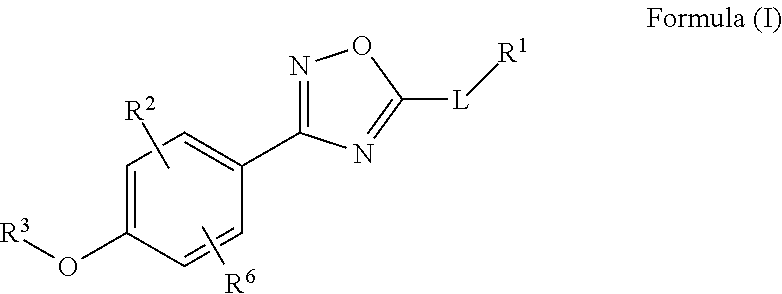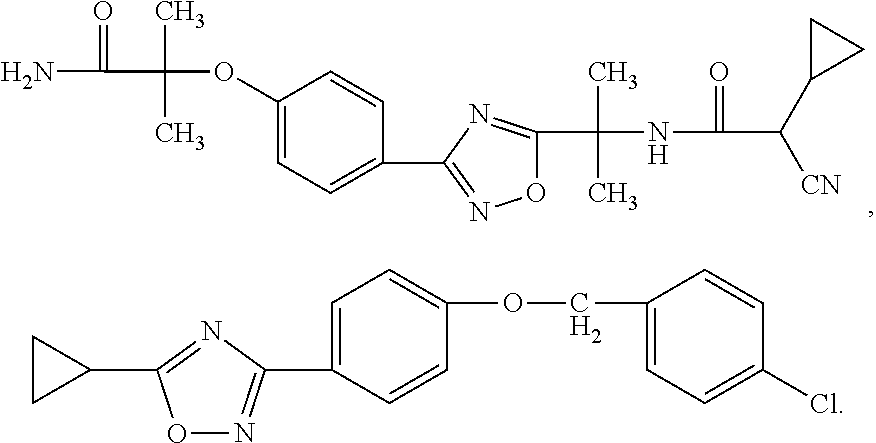Novel Oxadiazole Compounds
a technology of oxadiazole and compound, which is applied in the field of new oxadiazole compounds, can solve the problems of limited isolation and characterization of sip analogs that have potent agonist or antagonist activity of sip receptors, and the physiologic implications of stimulating individual sip receptors are largely unknown, so as to reduce the number of circulating and infiltrating t- and b-lymphocytes and achieve beneficial immunosuppressive effects
- Summary
- Abstract
- Description
- Claims
- Application Information
AI Technical Summary
Benefits of technology
Problems solved by technology
Method used
Image
Examples
preparation # 1
Preparation #1
Preparation of 3-chloro-4-isopropoxy-benzoic acid
[0611]
[0612]Into a round bottom flask was added triphenylphosphine (62 g, 0.263 mol), 3-chloro-4-hydroxy-benzoic acid methyl ester (10 g, 0.0535 mol) and anhydrous THF (500 mL). The mixture was briefly stirred under nitrogen, then DBAD (19.75 g, 0.0858 mol) was added. The mixture was stirred for a few minutes before adding anhydrous isopropanol (5.125 mL, 0.067 mol). After the reaction mixture was stirred at RT under an atmosphere of nitrogen for about 3 h, DBAD (19.75 g, 0.0858 mol) and anhydrous isopropanol (5.125 mL, 0.067 mol) were added and the mixture was left to stir at RT overnight. The solvent was removed under reduced pressure. The residue was dissolved in a minimum amount of ethyl acetate. Heptane was added and the precipitate was removed by filtration. The filtrate was brought up in methanol. Water was added until the solution was cloudy. The precipitate was filtered off The methanol / water precipitation proce...
preparation # 2
Preparation #2
4-(3-(3-chloro-4-isopropoxyphenyl)-1,2,4-oxadiazol-5-yl)benzonitrile
[0614]
[0615]3-Chloro-N-hydroxy-4-isopropoxybenzimidamide (10 g, 43.7 mmol) was dissolved in DMF (219 mL) under nitrogen. The mixture was heated at about 110° C. for about 10 min. A solution of 4-cyanobenzoyl chloride (7.24 g, 43.7 mmol) dissolved in DMF (30 mL) was added dropwise over about 20 min and the reaction heated at about 110° C. for about 4 h until LC / MS showed the reaction was complete. The reaction was cooled in an ice bath and poured into rapidly stirred water (1000 mL). The resulting white precipitate was collected by vacuum filtration and washed with water. The precipitate was dissolved in methylene chloride and washed with 1 N HCl and then brine. The methylene chloride was dried over sodium sulfate, filtered, and evaporated. Heptane and DCM were added to the residue and the mixture heated until the DCM had boiled off after which the mixture was allowed to cool. Solids did not dissolve in...
preparation # 3
Preparation #3
4-(3-(3-chloro-4-isopropoxyphenyl)-1,2,4-oxadiazol-5-yl)benzaldehyde
[0616]
[0617]4-(3-(3-Chloro-4-isopropoxyphenyl)-1,2,4-oxadiazol-5-yl)benzonitrile (10 g, 29.4 mmol) was dissolved in dichloromethane (535 mL) under nitrogen. The reaction was cooled to about −40° C. in a dry ice / ACN bath measuring the temperature internally. A solution of Dibal-H (58.9 mL, 58.9 mmol) was added dropwise and the reaction stirred for about 30 min. and then quenched with methanol. The mixture was stirred until the bubbles subsided. The mixture was then warmed to RT and stirred rapidly with a 10% solution of Rochelle's salt. The separated layers were extracted with DCM (3×100 mL). The combined extracts were stirred rapidly with about 100 mL of 1 N HCl and the solution turned from orange to colorless. TLC indicated the mixture had been cleaned up to just one spot with some baseline material. The layers were separated and the aqueous layer extracted with DCM (2×100 mL). The combined organic ex...
PUM
| Property | Measurement | Unit |
|---|---|---|
| Volume | aaaaa | aaaaa |
| Volume | aaaaa | aaaaa |
| Volume | aaaaa | aaaaa |
Abstract
Description
Claims
Application Information
 Login to View More
Login to View More - R&D
- Intellectual Property
- Life Sciences
- Materials
- Tech Scout
- Unparalleled Data Quality
- Higher Quality Content
- 60% Fewer Hallucinations
Browse by: Latest US Patents, China's latest patents, Technical Efficacy Thesaurus, Application Domain, Technology Topic, Popular Technical Reports.
© 2025 PatSnap. All rights reserved.Legal|Privacy policy|Modern Slavery Act Transparency Statement|Sitemap|About US| Contact US: help@patsnap.com



